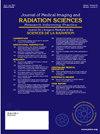Feasibility of low contrast volume and low injection flow rate in CT pulmonary angiography
IF 1.3
Q3 RADIOLOGY, NUCLEAR MEDICINE & MEDICAL IMAGING
Journal of Medical Imaging and Radiation Sciences
Pub Date : 2025-01-01
DOI:10.1016/j.jmir.2023.11.009
引用次数: 0
Abstract
Background
Computed Tomography Pulmonary Angiography (CTPA) is currently the gold standard for diagnosing Pulmonary Embolism (PE), with a high flowrate (>4.5ml/s) for contrast media (CM) administration recommended for sufficient pulmonary artery opacification. However, this may not be achievable for patients with challenging IV access.
Aim
To determine if a low volume CM, low flowrate (LVLF) CTPA protocol produces images of similar image quality compared to a standard protocol in two aspects, in terms of peak arterial enhancement through the quantitative measurement of Hounsfield unit (HU) and based on subjective overall image quality.
Methods
Retrospective collection of 151 patients who underwent CTPA via 320 slice multi-detector CT due to clinical suspicion of PE. 80 patients underwent the standard protocol, with a fixed flowrate of 4.5ml/s and 50ml of CM, while 71 patients underwent the LVLF protocol with up to a 37% and 30% reduction in flowrate and CM administered, respectively. Two independent radiographers measured the attenuation of multiple pulmonary arteries in HU, with ≥200HU being considered diagnostic. Overall image quality was also reviewed using a 5-point close-ended questionnaire by two independent radiologists.
Results
There was no significant difference in terms of attenuation measured in HU for the seven regions of interest (main pulmonary trunk, right and left pulmonary arteries, right and left lobar arteries, and right and left subsegmental arteries (RSA and LSA)) between the LVLF and standard CTPA protocol. Similarly, there were no significant differences in the overall image quality score obtained from standard and LVLF protocols reported by both radiologists.
Conclusion
The LVLF protocol can achieve similar enhancement and subjective image quality as the standard CTPA protocol, potentially allowing for further optimisation in the CM dosage.
在 CT 肺血管造影中使用低造影剂量和低注射流速的可行性。
背景:计算机断层扫描肺血管造影术(CTPA)是目前诊断肺栓塞(PE)的黄金标准,建议使用高流速(>4.5ml/s)造影剂(CM)以获得足够的肺动脉通透性。目的:通过对 Hounsfield 单位(HU)的定量测量和基于主观整体图像质量的测量,确定低容量 CM、低流速(LVLF)CTPA 方案与标准方案相比是否能在两个方面产生相似的图像质量:回顾性收集了 151 名因临床怀疑 PE 而通过 320 片多切面 CT 进行 CTPA 的患者。80名患者接受了标准方案,流量固定为4.5毫升/秒,CM剂量为50毫升;71名患者接受了LVLF方案,流量和CM剂量分别减少了37%和30%。两名独立的放射技师以 HU 为单位测量了多条肺动脉的衰减,≥200HU 被认为是诊断性的。两位独立的放射科医生还使用 5 点封闭式问卷对整体图像质量进行了评估:LVLF 和标准 CTPA 方案在七个相关区域(主肺动脉干、左右肺动脉、左右肺叶动脉、左右肺段下动脉(RSA 和 LSA))的衰减(以 HU 计)方面无明显差异。同样,两位放射科医生报告的标准和 LVLF 方案获得的总体图像质量评分也无明显差异:结论:LVLF 方案能达到与标准 CTPA 方案相似的增强效果和主观图像质量,有可能进一步优化 CM 剂量。
本文章由计算机程序翻译,如有差异,请以英文原文为准。
求助全文
约1分钟内获得全文
求助全文
来源期刊

Journal of Medical Imaging and Radiation Sciences
RADIOLOGY, NUCLEAR MEDICINE & MEDICAL IMAGING-
CiteScore
2.30
自引率
11.10%
发文量
231
审稿时长
53 days
期刊介绍:
Journal of Medical Imaging and Radiation Sciences is the official peer-reviewed journal of the Canadian Association of Medical Radiation Technologists. This journal is published four times a year and is circulated to approximately 11,000 medical radiation technologists, libraries and radiology departments throughout Canada, the United States and overseas. The Journal publishes articles on recent research, new technology and techniques, professional practices, technologists viewpoints as well as relevant book reviews.
 求助内容:
求助内容: 应助结果提醒方式:
应助结果提醒方式:


